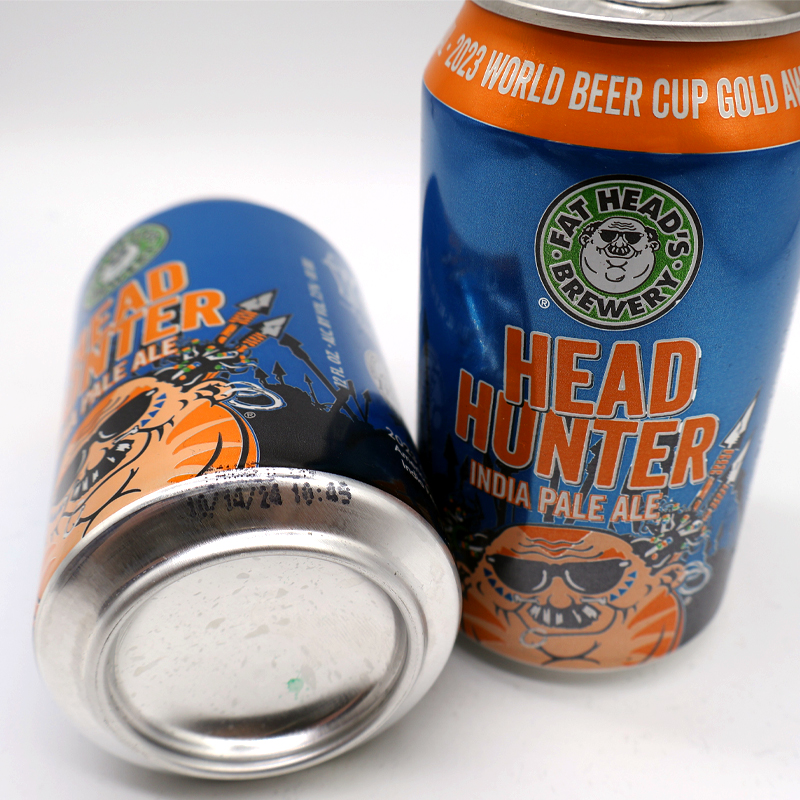Beer FAQs
When was my beer canned, and what's the shelf life?
Not all beer is created equal, but most should be consumed fresh. We date our beer on the bottom of the can (or case or keg) with the date and time that it is packaged. The format is month, day, the last two digits of the year, and the time of day (MM/DD/YY 00:00). See the image below for an example.
This beer was canned on 10/14/2024 at 10:49.

Full-flavored styles, like IPAs, will begin to lose their character after 90 days. Fruit-centric beers are best before 120 days. Lagers and Belgian-style beers are best before 180 days. Beers that are darker or have higher alcohol content are also best before 180 days.
All beer should be stored in cold and dark conditions. In case you didn’t know, that light turns off when you close your fridge.
Why do you provide “Canned On” dates instead of “Best By” dates?
The current beer consumer is becoming more and more educated. We wish to provide you with the information to make the best decision you see fit. You do you!
How long after the “Canned On” date should I drink my beer?
We believe fresh is best. It is better to enjoy our beers sooner rather than later to preserve freshness. But if the beer must wait on you, then have it wait in cold storage.
Where is Fat Head’s beer distributed?
Our current distribution footprint covers the states of Ohio, Pennsylvania, Indiana, Kentucky, Florida, and Western New York, with plans for further expansion in the works. We are partnered with Cavalier Distributing (OH, IN, and FL), Beer House (KY), Wilson-McGinley (Pittsburgh), W.R. Hickey (State College), Penn Beer (Greater Philadelphia), Wilsbach Distributing (Harrisburg and Central PA), Erie Beer (Erie, PA), and Inco Beverage (Johnstown & Altoona). Don’t see it on the shelf? Ask your favorite grocer or beer shop why.
Periodically, we drop small batches of our beer into new regions. Illinois, Michigan, and Colorado are on our list!
When will ____ beer be released?
Check out our release calendar for our schedule of seasonal releases. Limited-release and draft-only beers are just that, limited! We suggest using our Beer Finder to locate accounts with our beer.
Follow along on social media for announcements of upcoming planned and special releases.
Will you ship beer to me?
Sorry, that’s prohibited. But we like the way you think. Request it at your favorite store or bottle shop.
How can I find out when and where my favorite beer is on tap?
Whoa! One question at a time. But for both of these inquiries, just click the Beer Finder. And remember, our beer moves quickly, so there are no guarantees that any beer listed as “on tap” now will still be there when you pull up in that hot ’70s Camaro. So if you’re jammin’ for a Juju and the keg is kicked before you arrive, you have our apologies.
How can I find out which stores have my favorite Fat Head’s beer?
Use our Beer Finder to see which retailers in your area have our beer!
What does IBU mean?
International Bitterness Units are a standard for measuring the bitterness lent by hops used in the brewing process. Our hop-forward beers and IPAs land on the scale between 70-100. Several of our stouts also have an IBU above 50, however their inherent malt characteristics affect perceived bitterness.
What is the sediment I find in the bottom of my can/bottle?
Occasionally, sediment can form in the bottom ring of our cans, especially if it has been held cold and not jostled about for a long period of time. It’s ok. Chill out. All is well. It’s malt, yeast and hops. Read on for some nerdy bits:
Sediment is a byproduct of our natural settling and clarifying techniques, coupled with the fact that we do not filter our beer. We let time and gravity clarify it. We feel this is gentler on the beer and results in the aroma, flavor, and mouthfeel we desire. We put a lot of thought and resources into ingredient selection, so why rush the beer and beat up the fresh, vibrant hop and malt aromas and flavor?
From time to time, a combination of yeast and malt-derived proteins and hop particles begin to coagulate and settle to form a tight layer in the bottom of the can ring. As the beer is poured, the “stuff” will re-suspend, making the beer’s appearance cloudy or, in extreme cases, a few white or tannish chunks may carry over into your glass. This should not adversely affect the flavor of the beer. Again, it is yeast, malt, and hop particles – three of the four main ingredients of beer!
If the sediment is unsettling (puns for days), may we suggest you take one of two actions:
- Decant or pour the beer slowly into a clear glass and leave ¼ to ½ oz behind. A sacrifice to the beer gods. Our preferred method, as we love the appearance of our beers.
- Pop the top and drink from the can or bottle. You’ll never be the wiser. Plus, no dishes. What’s more chill than that?
Do you have gluten free food or beer?
Our Middleburg Heights Beer Hall, Pittsburgh, and Canton locations all offer gluten-free friendly food menus. Although we don’t currently brew gluten-free or gluten-reduced beer, many of our pubs do have GF options from guest breweries available.
How can I find out other nutritional information about your beer?
Please contact us and tell us more about the information you are seeking. We would love to help you.